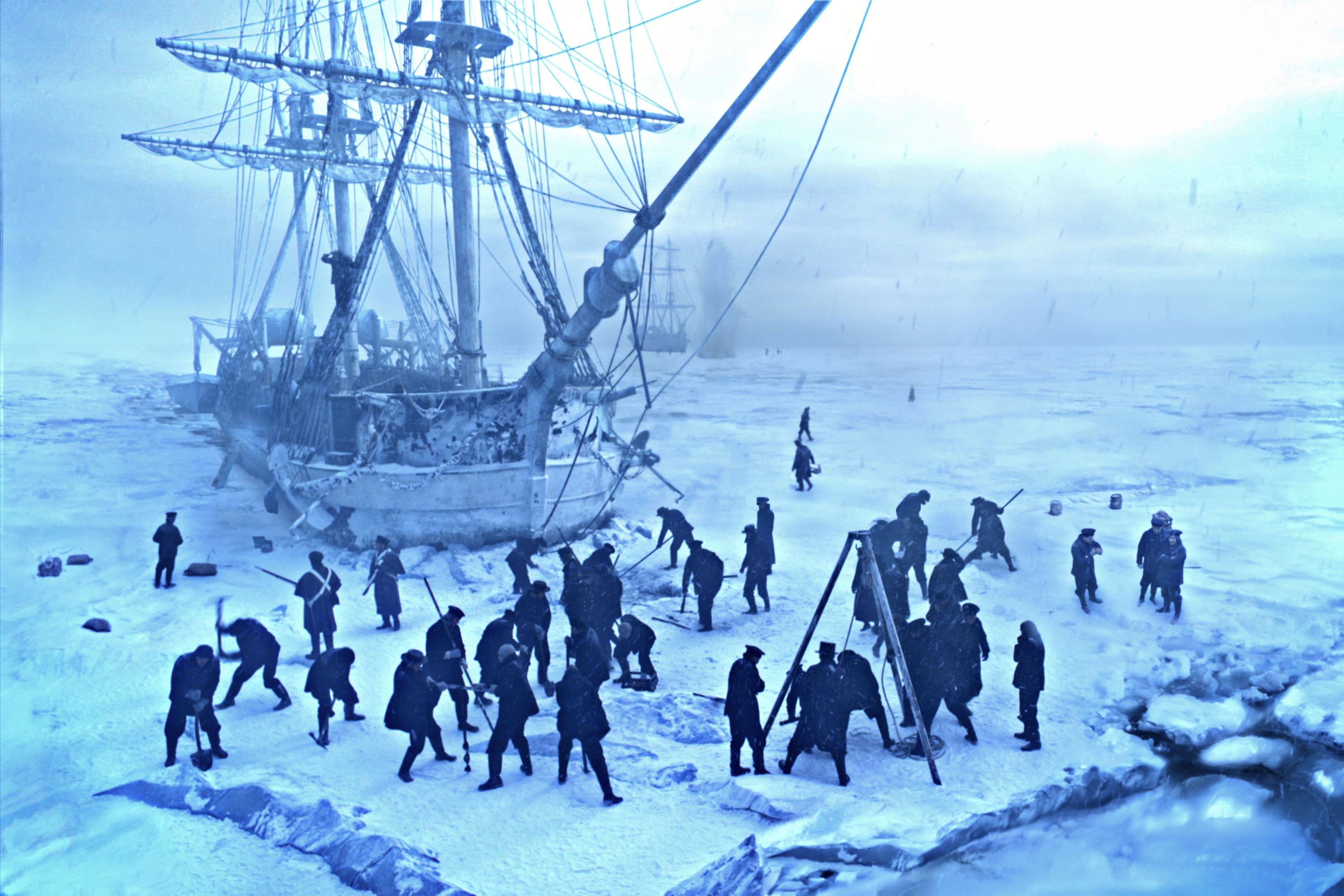
On Monday, AMC will premiere the first two episodes of The Terror, an adaptation of Dan Simmons’s 2007 novel of the same name. I’ve been excited about this series for a while, which takes the real-life 1800s Arctic expedition of the HMS Terror (and its companion ship, the HMS Erebus) and gives the tale a supernatural twist. These British Royal Navy officers didn’t just succumb to harsh conditions, lead poisoning in their food, and eventual cannibalism—they were also hunted by a monster from Inuit mythology hell-bent on destroying them.
At times, watching The Terror just feels brutal. The frigidity of the Arctic is conveyed through scenes such as the one in which a telescope rips some skin off an officer’s eyelid (because it’s cold), or another in which the ship’s doctor removes purplish, frostbitten toes from his shipmates (because it’s REALLY cold). A suggestion based on personal experience: Watch The Terror with a blanket and fuzzy slippers.
The Terror is also familiar, fertile ground for Hollywood—another spin on the well-oiled “Humans versus the Elements” genre. To name a few others: Cast Away; Everest; Aguirre, the Wrath of God; The New World; The Perfect Storm; and In the Heart of the Sea. It also has made its way to TV in various forms, though less frequently: The River, Naked and Afraid, Man vs. Wild, Lost, Gilligan’s Island (I’m already reaching), and now The Terror.
What is it about pitting man against nature that is so viscerally satisfying? To celebrate The Terror landing on the small screen, we’ve provided a handy guide to the genre: what every proper Humans versus the Elements epic needs, what these tales represent, which ones have been adapted from real-life events, and so forth. Let’s get started.
The Humans vs. the Elements Checklist
There are a ton of movies that could fall under the broader purview of the subgenre, but let’s avoid a couple of sub-subgenres. Post-apocalyptic movies (The Day After Tomorrow, I Am Legend) deal with futuristic conditions that don’t feel rooted enough in reality, and space movies (Gravity, The Martian) take place in, well, outer space.
The rest of the Humans vs. the Elements movies need to meet a few important criteria:
- A conflict with nature—whether it’s intense physical conditions (Mount Everest in Everest), an animal/monster of sorts (the shark in Jaws), or a bit of both (The Terror).
- There have to be real life-or-death stakes with the scenario presented. Apologies to Jeremiah Johnson, because Robert Redford’s titular mountain man was too cool to ever be in any danger.
- Man versus man conflicts within the man versus nature stories are fine (Anthony Hopkins and Alec Baldwin in The Edge) as long as they’re not at the expense of Mother Nature as its own character—like The Most Dangerous Game, which is about a man hunting other humans for sport. (The Edge had a Kodiak bear!)
Man vs. Nature Symbolism
These movies don’t all deal with the same themes and subtext, but there are a few familiar threads. First, let’s talk about the hubris of man.
The monster that hunts the naval officers in The Terror—what the men in Simmons’s book call that “thing on the ice”—is an embodiment of nature fighting back against humans arrogant enough to believe they can conquer the Arctic. There’s also the added layer that these are Westerners invading a foreign land, and the monster is the last form of protection for a marginalized people. One Inuit character in The Terror talks about how British colonialists tearing up the Arctic to create the Northwest Passage has damaged their usual food supply. The monster is payback. Compare these ideas with Werner Herzog’s Aguirre, the Wrath of God and the conquistadors invading South America in search of El Dorado, and you get the picture.
There’s also mankind taking Mother Nature for granted by greedily taking too much from our planet. In the Heart of the Sea is based on Nathaniel Philbrick’s eponymous nonfiction book, which tells the story that was the inspiration for Moby Dick. Whaling ships have ravaged the ocean—butchering whales for once-lucrative whale oil—to the point that ships have to venture to the middle of the Pacific Ocean to find surviving mammals to slaughter. For mankind’s insatiable bloodthirst, retribution comes in the form of a really pissed-off whale. What makes stories like this compelling are that they give a human characteristic—the desire for revenge—to an animal (How many whale-attack stories have you heard of?)
Sometimes, nature is just an asshole, and that’s also fine. In All Is Lost, Robert Redford is a yachtsman trying to do his yachting thing, and spends most of the movie trying not to die in the middle of the Indian Ocean while he’s getting wrecked by waves. A solemn reminder: Nature can never be tamed.
Finally, there’s nature as an effective backdrop for pitting people against one another. While there is a Kodiak bear attacking Hopkins and Baldwin in The Edge, the true conflict of the story is between their two characters: Hopkins is a billionaire whose supermodel wife is having an affair with Baldwin, who plans to kill Hopkins in the woods. (That their plane crashes and a bear stalks them is not part of the plan.) Using remote wilderness as the setting for a brash showdown of masculinity is supremely effective in The Edge—as is Hopkins’s assurance that he’s going to “kill the motherfucker” (he means the bear).
The Wildest, Real-Life Survival Stories
Did you know that after a great white shark attacked multiple beachgoers on Amity Island in the ’70s, three men lured the shark to open sea to kill it, one of them was eaten alive, and the remaining men killed the shark only once it had a scuba tank lodged in its mouth and it blew up? OK, Jaws definitely isn’t nonfiction—though Jaws author Peter Benchley was captivated by actual encounters with great whites—but there have been plenty of survival stories based on actual events. Let’s break down the four best ones, in no particular order.
127 Hours, as a movie, is surprisingly engrossing—despite it mostly being James Franco with one arm trapped underneath a boulder. The film is based on the real-life experience of canyoneer Aron Ralston, who turned the ordeal into a memoir with a fitting name: Between a Rock and a Hard Place. Ralston was a total badass; not only did he pull MacGyver-esque solutions out of his hat to sustain himself for several days, but he also [tries not to vomit] cuts off his own arm to escape and live to tell the tale. This guy was a true survivalist.
Some of the greatest survivalists were also rugby players. In 1972, a plane carrying members of a Uruguayan rugby team crashed in the Andes mountains, killing several passengers and members of the flight crew and marooning the rest in the middle of the mountains. Alive takes that real story—which involves cannibalism and a damn avalanche—to the big screen with actors like Ethan Hawke, John Malkovich, and Josh Hamilton, who are definitely not Latino actors. Whitewashing aside, it’s a brutal, compelling tale of survival.
Meanwhile, The Lost City of Z is less about a single adventure than it is about the life of British explorer Percy Fawcett. Fawcett was almost a mythical figure himself, constantly venturing into the Amazon on behalf of the Royal Geographical Society, and his own personal quest to find what he called Z—pronounced Zed—a lost, sophisticated civilization from another time. He’s been credited by some as the primary inspiration behind Indiana Jones, which is badass in and of itself. Fawcett’s eventual disappearance—along with his eldest son, Jack—in the Amazon only adds to his enduring legend.
Finally, it’s a shame that Ron Howard flopped with In the Heart of the Sea, because what these whalers actually endured is truly unreal. I highly recommend reading Philbrick’s nonfiction book, which details the bloody, once-thriving business of Nantucket’s whaling community and how one vengeful whale took down the Essex and stranded its crew in the middle of the Pacific Ocean with little chance of survival. The whale rams the boat many, many times—at one point backing up several hundred yards to ram it with more force. At least Howard’s movie got the whale attacks down pretty good.
The Best “Monsters”
Again, not all good man vs. nature movies need to have an actual animal standing in the way of the protagonists, but there have been many memorable adversaries you’d never want to cross paths with.
The shark in Jaws immediately comes to mind, a terrifying presence (those black, expressionless eyes!) that’s all the more frightening because we see very little of it. (Steven Spielberg had a lot of issues with the mechanical shark, but this minimal approach became an advantage for the film, not a bug.) And look, it’s just scary when the shark straight-up eats the foul-mouthed captain we all grew to love over the course of two hours.
Sharks, in general, get a pretty bad rap thanks to survival movies—Open Water and The Reef come to mind—and while real sharks aren’t nearly as bad, they make for great movie monsters. You have to meet a shark on its terms—in the ocean—where the shark has all the advantages over you. That’s some existentially freaky shit.
There’s also the wolf pack that follows Liam Neeson in The Grey. Clearly, these wolves never watched a Liam Neeson movie—they should’ve known not to mess with this guy—but they were able to wipe out the remaining survivors of a plane crash in the Alaskan wilderness. And what’s scarier than one animal hunting you down? An entire pack of animals!
And then, of course, there are bears—specifically, the “motherfucker” of a bear in The Edge and the one that helped land Leonardo DiCaprio an Oscar in The Revenant. What’s freaky about bears is that they’ll occasionally (though it’s quite rare) go to great lengths to kill a person in the woods. Wolves are kinda like dogs, which sometimes makes them cute. Don’t wanna mess with a shark? Stay out of the water! Bears, on the other hand, will rummage through neighborhood trash bins, and they are absolute units.
Just ask poor Leo, who was definitely muttering under his breath, “I better get an Oscar for this bullshit.”
The Crappiest Atmospheres
Of crucial importance to the Humans vs. the Elements genre is getting the atmosphere right—the kind of place that sends shivers down your spine just thinking about it, where you can’t even pretend that you’d survive the same ordeal. Here are a few places I’d never, ever visit.
In ABC’s The River, a tragically unseen supernatural horror series canceled after one season, a group ventures into the Amazon to find the Steve Irwin-esque explorer Emmet Cole (Bruce Greenwood) after he mysteriously vanished half a year before while looking for “magic” in the rainforest. It doesn’t take long for the rescue mission to understand why this guy disappeared. The part of the Amazon that Cole explores is haunted—like, “creepy dolls hanging from tree branches and turning their heads” kind of haunted. The Amazon is a vast, enigmatic terrain, and is similarly foreboding in films like The Lost City of Z and Aguirre, the Wrath of God. Giving it a supernatural flourish makes perfect sense.
I’ll contend that the series was too out-there for a mainstream, network TV audience. It’s a shame The River never found a home on a network like AMC, where we could’ve explored the creepy-ass jungle for more than eight short episodes.
Also bad? The seemingly endless desert of Gus Van Sant’s Gerry. Gerry follows two men who both go by Gerry—played by Casey Affleck and Matt Damon—and get lost on a hike and need to find their way back to civilization before succumbing to dehydration. Van Sant’s movie makes the desert landscape almost alien in nature: beguiling terrain, stretching as far as the eye can see. Suffice it to say, you won’t want to embark on any adventurous hikes after watching Gerry, unless you have a really good cellphone plan.
On the other side of the weather spectrum, I have a proposal: People shouldn’t try to climb a giant mountain. Just ask the group of hikers from Everest—a huge snowstorm at the peak killed a bunch of experienced mountain men and women—or the two climbers who nearly died trying to make it to the top of Siula Grande in the docudrama Touching the Void. Mountains? Bad.
The Most Badass Movie Survivalist (and a Runner-Up)
In The Terror, most of the men aboard the HMS Terror and HMS Erebus are totally unprepared for the harsh conditions of the Arctic and the monster that’s hunting them. And that’s one form of entertaining cinema: watching people get completely owned by animals and the elements. Sometimes, however, the Humans vs. the Elements genre gives you survivalists who are challenged by Mother Nature—and they fight back impressively.
Tom Hanks in Cast Away is a good example. He’s stranded on an island with nothing but a Wilson volleyball for company, and he has to figure out a way to live on the island for a very long time. Eventually, he learns how to spear fish, and removes a bad tooth with a rock. Bear Grylls, eat your heart out.
But even Hanks’s Chuck Noland feels like a distant second to “Our Man,” Robert Redford’s character in All Is Lost. Redford barely speaks a word in the film; his sole focus is trying to keep his yacht afloat after a stray shipping container rips a hole in the hull. There are several points in All Is Lost when you think, “OK, this is it, our guy’s going to die” but he perseveres through a giant tropical storm, a broken radio, SHARKS, and a lack of food or fresh water. By the time an outstretched hand reaches to pluck him out of the water at the end of the film—after he signals a boat by setting his own damn raft on fire—you will know you’ve just witnessed someone surviving the decathlon of Human vs. the Elements movies and all of the genre’s possible obstacles. Hell yeah.
If the initial premise of The Terror sounds right up your alley, or you’ve mostly missed out on Hollywood’s Humans vs. the Elements craze and want to binge some from the genre, here’s a handful worth checking out—in no particular order—and where you can watch them online.
- Alive (Netflix)
- Into the Wild (Netflix)
- The Way Back (Netflix)
- The Lost City of Z (Amazon Prime)
- All Is Lost (Amazon Prime, Hulu)
- Open Water (Hulu with Showtime)
- The Descent (Netflix)
- A Lonely Place to Die (Netflix)
- The River Season 1 (ABC)
Happy binge-watching, couch explorers.

